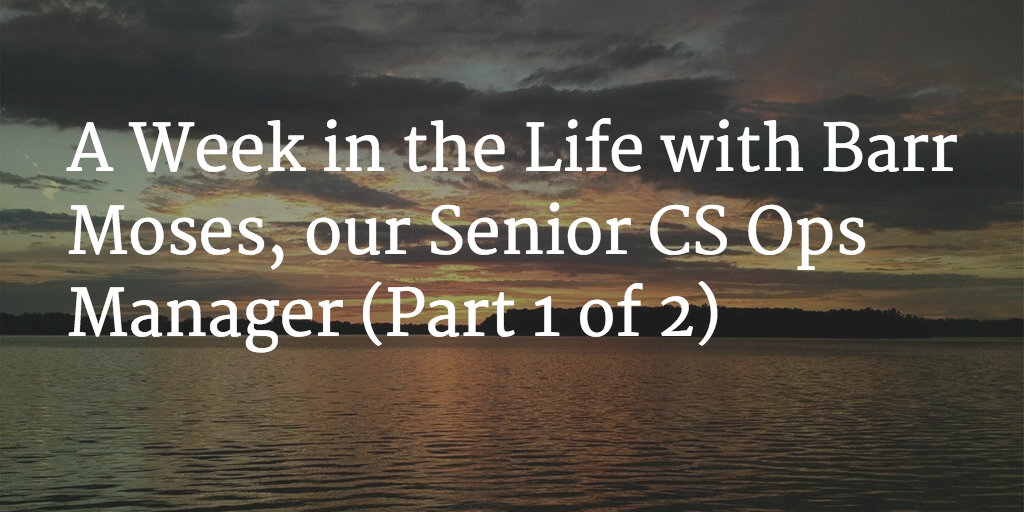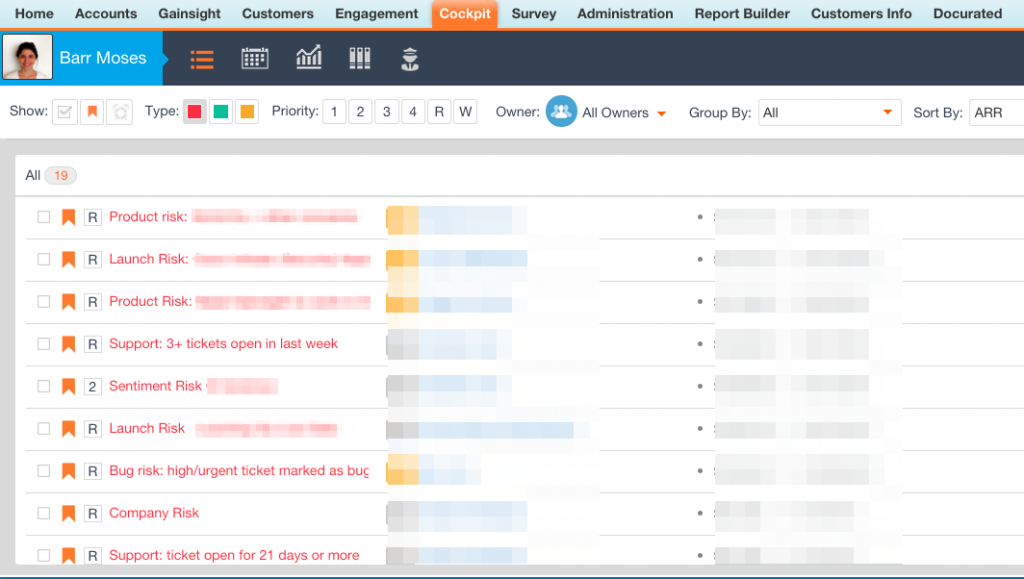As part of an ongoing discussion about the evolving role of Customer Success Operations, we have a special guest blog post from our very own Senior CS Ops Manager, Barr Moses. Below, she takes us through a week in her life here at Gainsight.
Hi everyone! Barr here, following a week in my life as a Customer Success Ops Manager (aka CS Ops Manager) at Gainsight. I see my team’s mission statement as taking the actions necessary to enable Gainsight to be a leader in customer success.
Breaking this down, there are two vital and overlapping components:
- First, I need to provide my CSM team the tools and processes they need to be efficient and effective.
- Just as important, I need to advocate for customer success across functions as a key company mission. This is where I work cross-functionally with sales, services, product, support, and other departments to make sure we have full engagement and highly effective processes to make CS effective at Gainsight.
In my day-to-day as a CS Ops Manager, my mission statement is my North Star. Additionally, I leverage the Gainsight platform as much as possible to help me scale processes. For instance, My goal is to run all of our meetings from within the Gainsight dashboards and cockpit views!
With that in mind, let’s dive in!
Starting Your Week as a CS Ops Manager
First thing every Monday morning, I lead a GM meeting with the CEO, CCO, and VPs of Product, Services, Support, Customer Success, Engineering, and Sales. The goal is to review the top customers at risk so that the leadership team has full visibility and can support the teams as needed. I prep by reviewing cockpit and scorecards which show qualitative and quantitative metrics for our top accounts. If all goes well, this early week alignment leads to fewer fires to put out and a streamlined process on our most critical weekly goals.
As I outlined above, one of my critical responsibilities is to coordinate across functions, ensuring that customer needs are met efficiently and effectively. Risk meetings are my way of ensuring that cross-functional coordination for our “at-risk” customers. Risk meetings work best when you can diagnose the potential reason for why a customer is at risk (delay in implementation, urgent support ticket, for instance) and then get the right people in the room to troubleshoot and fix problems. Monday afternoon is when we hold our implementation risk meeting.
A day prior to the meeting, our project managers flag their accounts in the midst of implementation that are facing challenges. The services team preps for the meeting and during this time, we discuss live and brainstorm solutions for any of the hangups that might be preventing us from implementing the product smoothly. Cockpit is critical for us during this session. It allows us to prioritize the right accounts and quickly get to the core issue in each case.
Another critical aspect of my job is to make sure my core customer, our CSMs, have all the tools they need to succeed. I am constantly thinking about how to improve their process. Therefore, I have started implementing processes to make sure I keep an active ear listening to their needs, literally a “process for my process”. I find that early afternoons on Monday are a great time to invest in some one-on-one time with the CSMs. We grab a coffee and chat for 15 to 30 minutes and have an open conversation about what’s working well for them and what could be improved. In addition to this informal setting, I also set up weekly office hours for anyone to pop by with thoughts and soon I’m planning on implementing a monthly survey to gather feedback and measure the effect of new processes.
Rolling into Tuesday
Weekly CSM team meetings occur on Tuesday mornings. The meeting is led by our VP of Customer Success, Allison Pickens. We are working on a new process where a portion of the agenda will be fixed, including a “state of the union” where we will discuss the top events from the prior week (renewals, upsells, risk mitigation), the top risks, and opportunities for the upcoming week, and gather input for upcoming renewals. We will also make sure our CSMs have the support they need in delivering value to our customers.
To support this process, we’re developing a dashboard to help guide these meetings. Ideally, the data should highlight the most important issues at the most important accounts that could benefit from the intelligence of the group. I consider the session a success every time the collective group resolves a problem faster or better than any individual CSM could have by themselves.
Coming out of the meeting, my mind goes to another process – new customer onboarding. On an on-going basis, as a CS Ops Manager, I review our new customers and make sure that they are set up for success. Is the data in Salesforce correct? Is the right CSM assigned? Are services resources available to deliver? Are they receiving the right onboarding communication? Once everything is in place, I send an email to our GM team to make sure we’re in total alignment to successfully deliver value for our customers.
Managing Unexpected Things
Halfway through drafting my email, I see a member of the CSM team rushing towards me. She points me to her Customer 360 view and shows me usage data that’s not loading properly. Additionally, she has a meeting with the customer in a few hours with our CEO. Our CSMs are our super users, so they’re always the one’s the find product glitches first! I need to troubleshoot fast.
First, I try to troubleshoot the problem myself. Is the data issue impacting more than just her account? I select a sample of accounts and find that the issue is in fact across the system. I then check the rules engine using my administrator credentials. Looking at the Rules Engine and QA dashboard, I see that things are running as they should – the tests are checking out fine, which doesn’t explain the root cause of the data issue. Seems like this issue is broader than just this user and customer. I need to do two things: get the message out and bootstrap a solution.
I email the CSMs to notify them of the problem. I reach out to support to get them started on the medium-term fix. I post the problem to the product team via Chatter so they can keep track of it for future releases.
OK, the message is out. Now to bootstrap a short-term solution. I will have to circle back with you all later this week! To be continued…

